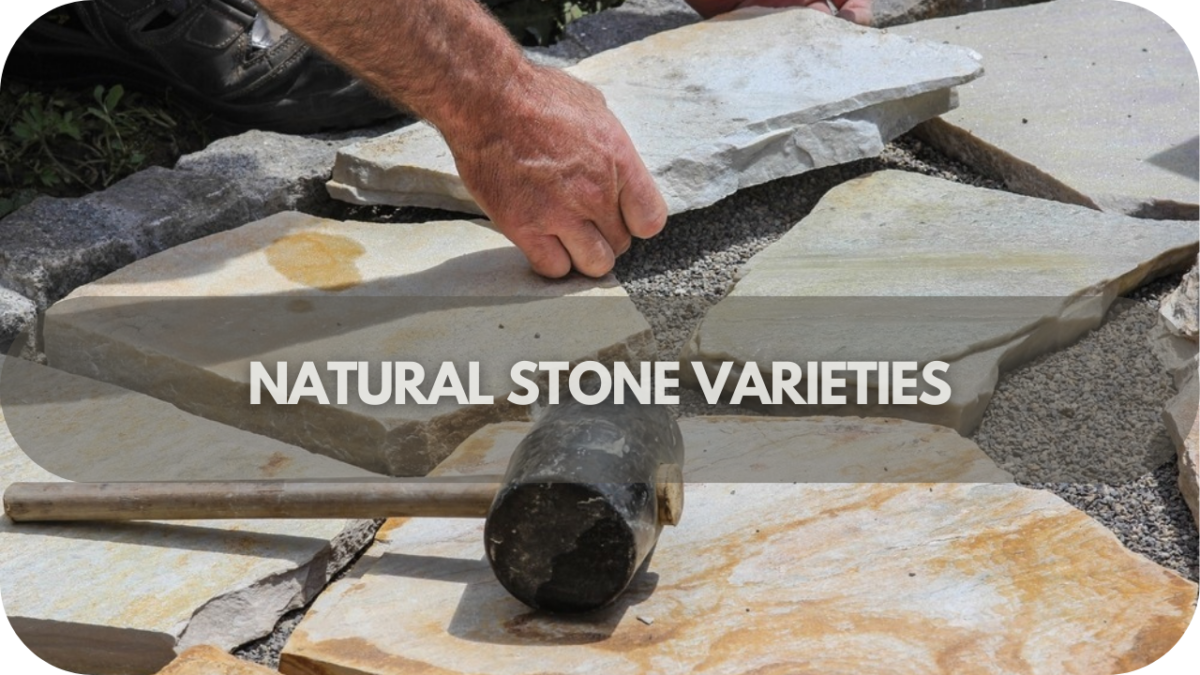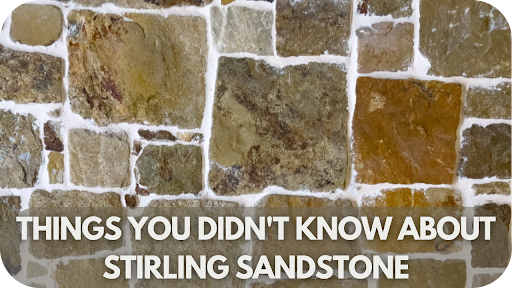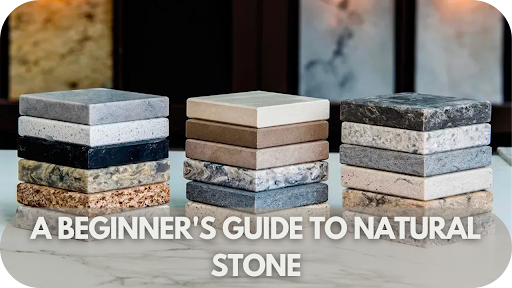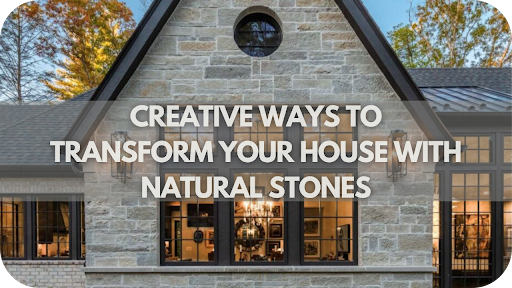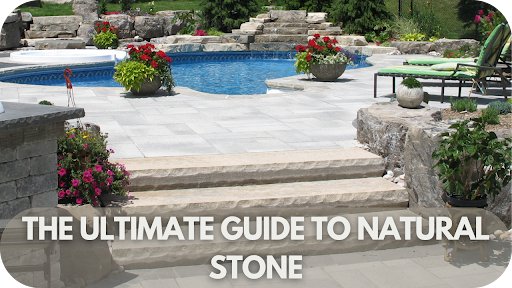Natural Stone Varieties: A Guide to Beautiful and Durable Choices
Choosing the perfect natural stone for your home can transform its aesthetic appeal while ensuring lasting durability. From timeless granite to luxurious marble, each stone offers unique benefits and challenges.
But with so many options available, how do you make the right choice? This guide will break down the most popular natural stones and help you select the ideal one for your needs.
Popular Types of Natural Stone
Natural stone comes in a variety of types, each with its characteristics that influence both its beauty and durability. Here are some of the most commonly used options:
1. Granite
Granite is a highly versatile and durable natural stone, known for its strength and resistance to wear. It is one of the toughest stones available, making it an excellent choice for high-traffic areas like kitchen countertops and even outdoor surfaces.
Its impressive resistance to scratches, stains, and heat ensures that it remains in top condition for years, even with frequent use. Granite’s diverse range of colours and patterns adds significant aesthetic value, allowing homeowners to select the perfect stone that suits their style.
Whether you prefer deep, dark tones or light, speckled hues, granite provides a broad spectrum of options. Due to its durability, granite is also ideal for use in exterior applications, such as driveways or outdoor kitchens.
While granite may require occasional sealing to protect against staining, its strength makes it a long-term investment for any home or commercial space.
2. Marble

Marble is widely regarded as a symbol of luxury, elegance, and timeless beauty. This stone’s unique veining and soft texture make it a popular choice for high-end residential spaces, particularly in bathrooms, foyers, and decorative feature pieces. While marble is softer and more prone to scratching compared to granite, its classic appeal remains unmatched.
The intricate veining, which varies from subtle to bold, adds visual interest and refinement to any room. Marble is perfect for bathroom surfaces, including vanities and shower surrounds, as it provides an opulent finish.
However, due to its porosity, marble requires regular sealing to prevent staining from water and acidic substances. It’s also important to clean marble with pH-neutral cleaners to avoid damaging the stone. For those seeking a stone that combines beauty with function, marble is an excellent choice, provided it’s properly maintained.
3. Slate
Slate offers a natural, rustic charm that’s perfect for creating earthy, warm spaces. This stone is highly durable, resistant to water, and boasts a non-slip surface, which makes it an excellent option for flooring in both residential and commercial settings.
Slate’s resilience against extreme weather conditions also makes it ideal for use in outdoor areas like patios, walkways, and pool decks. It requires minimal maintenance and can withstand heavy foot traffic without losing its appearance.
Slate’s textured surface not only adds a tactile quality to spaces but also provides a variety of colours, including deep greys, greens, and purples, which further enhances its visual appeal.
While slate is naturally less porous than other stones, sealing it can help preserve its look, especially in areas exposed to moisture. Whether used indoors or outdoors, slate brings both function and beauty, making it a popular choice for many homeowners.
4. Limestone

Limestone is a natural stone that offers a warm, earthy aesthetic, making it a popular choice for residential and commercial flooring, wall cladding, and fireplaces. Its soft, muted colours create a serene and inviting atmosphere, making it ideal for creating calm and neutral interiors.
Though softer than granite and more prone to scratching, limestone retains impressive durability, particularly for indoor spaces. It is also more porous than granite, so proper sealing is essential to prevent stains from liquids, oils, or even acidic substances.
Limestone’s unique appearance often features subtle fossils, adding character and a sense of history to the material. It’s an excellent choice for creating rustic or Mediterranean-inspired designs.
However, for optimal maintenance, sealing and regular cleaning with mild, pH-neutral solutions are key. When properly cared for, limestone adds both charm and durability to any space, making it a favourite in both modern and traditional homes.
5. Travertine
Travertine is often selected for its distinctive, naturally occurring pits and troughs that give it a one-of-a-kind character. This stone is highly durable, making it an excellent option for use in flooring, backsplashes, and even outdoor applications like patios and pool decks.
Travertine’s textured surface provides a non-slip quality, making it ideal for wet areas. The stone is available in various colours, ranging from light beige to golden and reddish tones, allowing for versatility in design.
However, travertine does require more maintenance than other stones. It is more porous than granite or marble, so sealing is essential to protect against staining and water absorption.
Over time, the surface may need to be re-sealed to maintain its appearance. Regular cleaning and care are needed to preserve the stone’s beauty, but its natural charm and durability make it a worthwhile investment for those willing to commit to upkeep.
6. Quartzite

Quartzite is a beautiful and highly durable natural stone that closely resembles marble but offers superior strength. It’s incredibly resistant to heat, scratches, and stains, making it a great choice for areas that experience heavy use, such as kitchen countertops and bathroom surfaces.
Quartzite is harder than granite, which means it can withstand everyday wear and tear more effectively. Although it shares some similarities with marble in terms of its appearance, with intricate veining and a polished look, it is much more durable and less prone to damage.
Quartzite’s elegant aesthetic and tough composition make it an excellent choice for both residential and commercial applications. Like marble and granite, quartzite should be sealed to preserve its beauty and prevent stains.
The material’s resistance to weathering also makes it suitable for outdoor applications like paving and garden features. Quartzite offers a luxurious yet practical solution for those seeking both beauty and durability in their natural stone.
Key Factors to Consider When Choosing Natural Stone
When selecting a natural stone, it’s important to weigh several factors to ensure it fits both your practical needs and aesthetic desires. Here’s a quick guide to help you make the best choice:
- Durability: Consider how much wear the stone will endure. Granite and quartzite are tough, while marble and limestone are more delicate and need extra care.
- Maintenance: Some stones require minimal upkeep. Granite and slate need little maintenance, while marble and limestone require regular sealing.
- Aesthetic Appeal: Choose a stone that complements your design. Marble offers elegance, while slate adds rustic charm.
- Cost: Stone prices vary. Granite is affordable, but marble and quartzite can be more expensive. Invest in durable stone for long-term savings.
- Application: Consider where it’s used. Granite is ideal for high-traffic areas, while marble works best for less-used spaces or decorative features.
Best Natural Stones for Specific Applications

Different types of natural stones suit various applications depending on their characteristics. Here’s a guide to the best options for specific uses:
1. Kitchen Countertops
Granite and quartzite are top choices for kitchen countertops due to their exceptional durability, resistance to stains, and low maintenance requirements. These stones are heat-resistant and can handle the demands of daily cooking and food preparation.
They are perfect for busy kitchens, with granite being particularly popular due to its wide range of colours and patterns. While marble also adds a touch of elegance, it is more prone to staining and scratching, requiring regular sealing and extra care to maintain its pristine appearance.
2. Bathroom Surfaces
Marble and travertine are highly sought-after for bathroom surfaces thanks to their smooth texture and timeless aesthetic appeal. Marble exudes luxury, making it a great choice for upscale bathrooms, while travertine offers a more rustic, earthy charm.
Both materials, however, require sealing to protect against moisture absorption and staining, particularly in high-humidity areas like showers. Regular cleaning with non-abrasive solutions is necessary to preserve their beauty and ensure their longevity in wet environments.
3. Outdoor Landscaping

When it comes to patios, driveways, and walkways, slate, granite, and travertine are the most reliable natural stones for outdoor use. Slate is ideal for its non-slip properties, making it safe for wet areas around pools and patios.
Granite is extremely weather-resistant and can handle extreme temperature fluctuations, making it perfect for high-traffic outdoor areas. Travertine, with its warm, natural tones, creates a rustic charm that blends beautifully with outdoor landscapes, but it should be sealed regularly to protect it from the elements.
4. Fireplace Surrounds
Marble and limestone are excellent choices for fireplace surrounds, providing both beauty and functionality. Marble’s luxurious appearance adds sophistication and a sense of opulence to any living space, while limestone’s softer, more natural look offers a grounded, earthy aesthetic.
Both materials are heat-resistant and can withstand the demands of a fireplace. Sealing is essential to prevent soot and heat damage, ensuring that the stone remains pristine while enhancing the overall warmth and ambience of your home.
Benefits of Using Natural Stone

Natural stone offers a range of benefits that make it a top choice for homeowners looking to enhance their living spaces. Here are just a few advantages:
- Longevity: Natural stones are extremely durable and can last for decades or even centuries with proper care. Unlike synthetic materials, they retain their beauty and functionality for many years.
- Unique Appearance: Each piece of natural stone is unique, with its pattern, colour, and texture, making it a one-of-a-kind addition to your home. From subtle veining to bold patterns, natural stone offers unmatched aesthetic appeal.
- Sustainability: Natural stone is eco-friendly, as it’s sourced directly from the earth and requires fewer resources to produce than manufactured materials. Many natural stones are recyclable, making them a sustainable choice for the environment.
- Increases Property Value: Investing in natural stone can enhance your home’s value. High-quality stones like granite and marble are highly desirable and add both beauty and durability, which appeals to potential buyers.
Conclusion
Selecting the right natural stone for your home doesn’t have to be overwhelming. By considering factors such as durability, maintenance, and aesthetic appeal, you can find the perfect stone for your needs.
Whether renovating a kitchen, enhancing your garden, or adding a feature wall, natural stone is a timeless, durable choice. Ready to make your selection? Transform your home today!

